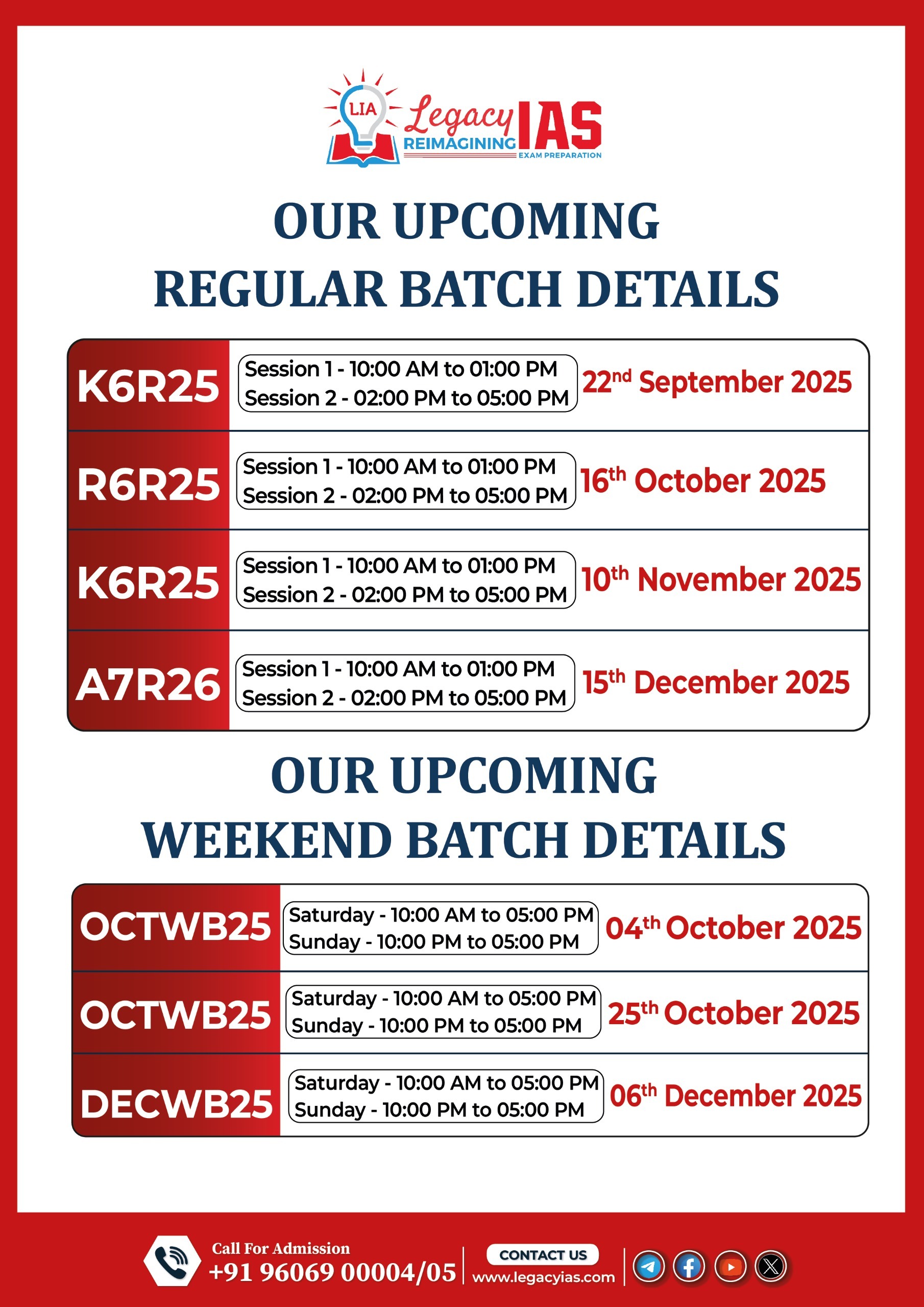Content
- Understanding Mental Health
- National Legal Services Day
Understanding Mental Health
Why in News?
- The PIB highlighted India’s expanding mental health architecture, including Tele MANAS, Ayushman Arogya Mandirs, and Economic Survey 2024–25 focus on mental well-being as a pillar of human capital.
- It signals a policy shift — mental health as a public health and developmental priority, not just a medical issue.
Relevance
• GS 2 (Governance): Government Policies & Implementation Issues in Public Health; Institutional Mechanisms (NMHP, Tele MANAS).
• GS 2 (Social Justice): Welfare Schemes for Vulnerable Sections; Inclusive Growth and Social Security through Mental Health Integration.
• GS 4 (Ethics): Emotional Intelligence, Empathy, and Compassion in Public Administration.
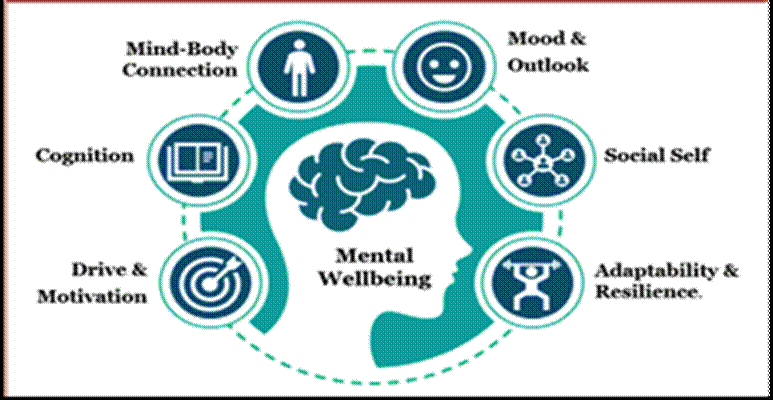
Understanding Mental Health – The Basics
- Definition (WHO, 2022): A state of well-being where individuals realize their abilities, cope with life stress, work productively, and contribute to society.
- Mental health ≠ absence of illness – it includes emotional, social, cognitive, and physical well-being.
- Basic human right: Affirmed by the UN and WHO, linking it to SDG 3 (Good Health & Well-being).
Global Burden and Data
- 1 in 7 people (1.1 billion globally) live with a mental disorder (WHO, 2021).
- Mental disorders = 5.2% of global disease burden (Lancet, 2020).
- Depression → 6.2% of YLDs
- Anxiety → 4.7% of YLDs
- Suicides: ~727,000 deaths/year worldwide (WHO, 2025).
- Economic Loss: US$1 trillion annually due to productivity loss (WHO, 2025).
- Projected global cost: US$16 trillion by 2030 (Journal of Mental Health, 2021).
Observation: Mental illness is now as economically costly as cardiovascular diseases or cancer, but underfunded (<2% of global health budgets).
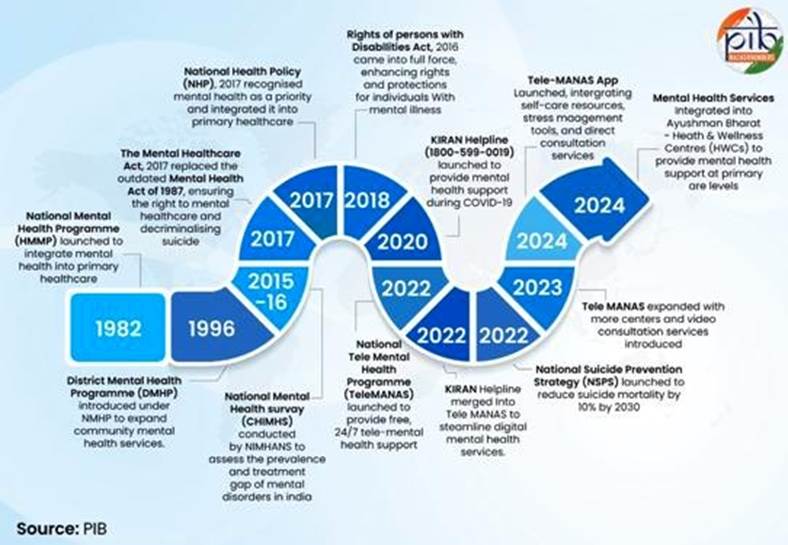
Indian Scenario – Scale and Trends
- Prevalence (NIMHANS Survey 2015–16):
- 10.6% adults have diagnosable mental disorder.
- 15% need active intervention.
- Urban prevalence = 13.5% vs. rural = 6.9%.
- Gender divide (NIMHANS, 2019):
- Women (20%) > Men (10%); depression and anxiety more prevalent among women.
- Suicides (NCRB, 2023):
- 1,71,418 suicides.
- Males: 72.8%, Females: 27.2%.
- Major causes: family problems (32%), illness (18%), unemployment (9%).
Treatment Gap & Human Resource Deficit
- Treatment gap: 70–92% (NIMHANS Survey 2016).
- Psychiatrist density:
- India = 0.75/100,000 vs. WHO norm = 3/100,000 (Garg et al., 2019).
- Key Causes:
- Stigma, low awareness, inadequate infrastructure, and poor insurance coverage.
Impact Dimensions
a) Health Impact
- Mental disorders increase risk of cardiovascular diseases by 72% (Lancet Psychiatry, 2025).
- Co-morbidities: obesity, diabetes, chronic pain, sleep disorders.
b) Economic Impact
- WHO (2025): Mental disorders → $1 trillion productivity loss/year globally.
- In India, estimated ₹2.9 trillion annual loss due to mental illness (Lancet, 2019).
c) Social Impact
- Isolation, family strain, and poor social integration; stigma worsens marginalization.
- Stigma (APA, 2024): structural & internalised stigma → delayed treatment seeking.
d) Youth Vulnerability
- 50% of mental illnesses begin by age 14, 75% by age 24 (WHO, 2020).
- Correlation with school dropout, self-harm, and substance abuse (Lancet, 2017).
COVID-19: The Tipping Point
- 25% global rise in anxiety & depression (WHO, 2021).
- Causes: isolation, uncertainty, economic stress, and fear of infection.
- India saw a 4X rise in mental health helpline calls (MoHFW, 2021).
Global Frameworks
WHO Comprehensive Mental Health Action Plan (2013–2030)
- 4 Pillars:
- Leadership & governance
- Community-based care
- Prevention & promotion strategies
- Research & data systems
WHO World Mental Health Report (2022)
- Three Transformations:
- Deepen value & commitment to mental health
- Reshape social & economic environments
- Strengthen community-based mental healthcare
India’s Policy Architecture
a) National Mental Health Programme (NMHP, 1982)
- Integrates mental health into general healthcare.
- Focus on awareness, early detection, and community-based interventions.
b) District Mental Health Programme (DMHP, 1996)
- Coverage: 767 districts (2025).
- Services: OPD, 10-bedded inpatient wards, counselling, suicide prevention.
- Model: Community-centric, decentralised mental healthcare.
c) National Suicide Prevention Strategy (NSPS, 2022)
- Goal: 10% reduction in suicide deaths by 2030.
- Focus on schools, workplaces, and high-risk groups (farmers, youth).
Capacity Building & Digital Initiatives
Manpower Development
- 47 Govt mental hospitals (3 Central, 44 State-run).
- 25 Centres of Excellence established (2007–2018).
- Digital Academies: NIMHANS, LGBRIMH, CIP Ranchi – 1.76 lakh trained professionals.
Ayushman Bharat Integration
- 1.75 lakh SHCs/PHCs → Ayushman Arogya Mandirs integrating mental healthcare.
- PM-JAY coverage: 22 mental disorder procedures; ₹120 crore authorised claims (2021–24).
- Telepsychiatry: Access in remote areas via Tele MANAS.
Digital Revolution in Mental Health – Tele MANAS
| Feature | Detail |
| Launch | Oct 10, 2022 (World Mental Health Day) |
| Coverage | All 36 States/UTs |
| Helpline Nos. | 14416 / 1-800-891-4416 |
| Usage | 2.83 million calls (as of Oct 2025) |
| App & Video Consultations | Pilot (TN, KA, J&K, 2024) → Nationwide (June 2025) |
| Recognition | WHO-endorsed model (2024) |
| Innovation | Escalation from audio to video; AI-assisted screening tools planned |
Economic Survey 2024–25 Recommendations
- Treat mental health as pillar of demographic dividend.
- Whole-of-community approach – integrate family, schools, workplaces.
- Focus Areas:
- School mental health curricula.
- Workplace stress management.
- AI-driven and tele-mental health expansion.
Persistent Challenges
- <2% of India’s health budget allocated to mental health (2024–25).
- 70% treatment gap remains.
- Lack of district–level specialists and rural outreach.
- Social stigma and limited insurance uptake for psychiatric disorders.
Way Forward
- Integrate with UHC: Mental health within primary care services.
- Expand Tele MANAS: Link with National Health Digital Mission.
- Workforce scaling: Bridge psychiatrist gap via paramedical and tele-supervision models.
- School & Workplace focus: Early detection + psychosocial training.
- Public awareness: De-stigmatization campaigns, peer support networks.
- Data-driven policymaking: Standardized mental health indicators in NFHS, NSSO surveys.
Conclusion
- Mental health is integral to human development and economic productivity.
- India’s paradigm has shifted from “custodial care” → “community-based, digital-enabled, preventive mental health”.
- Sustaining this momentum requires higher investments, stigma eradication, and inter-sectoral coordination — only then can “India’s mental well-being become its true demographic dividend.”
National Legal Services Day
Why is in news ?
- November 9, 2025 marks National Legal Services Day, commemorating the Legal Services Authorities Act, 1987, which came into force on 9 November 1995.
- The Department of Justice and NALSA released updated data (2022–25) highlighting major achievements in free legal aid, Lok Adalats, Tele-Law, DISHA, and LADCS schemes.
Relevance
• GS 2 (Governance): Welfare Schemes for Vulnerable Sections; Role of Statutory Bodies (NALSA, SLSA, DLSA); Government Policies and Implementation.
- GS 2 (Social Justice): Access to Justice, Legal Empowerment, and Social Inclusion.
Constitutional Basis
- Article 39A (Directive Principles): Mandates the State to ensure equal justice and free legal aid.
- Articles 14 and 22(1): Guarantee equality before law and the right to counsel.
- The Legal Services Authorities Act, 1987 operationalized these principles.
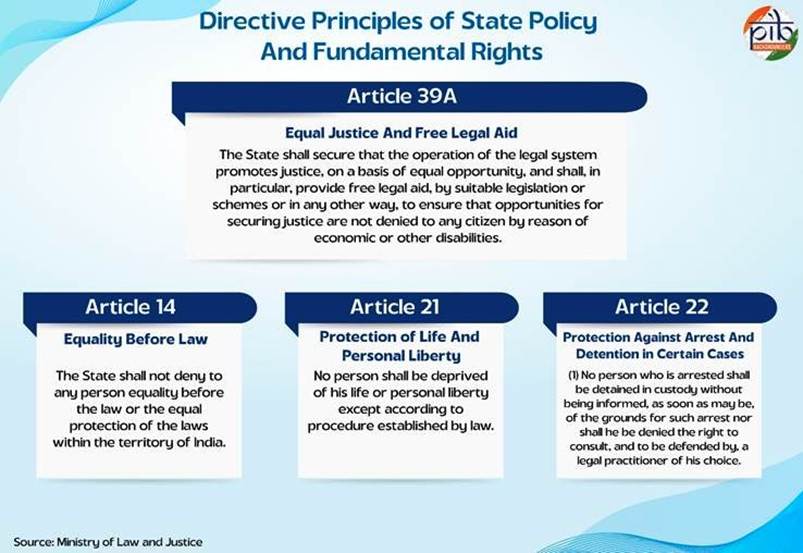
Historical Context
- Before 1987, legal aid was fragmented through state initiatives (e.g., Bombay Legal Aid Society, 1952).
- The 1980 Committee on National Implementation of Legal Aid Schemes (CILAS) led by Justice P.N. Bhagwati laid the groundwork for a uniform legal aid system.
- The Act of 1987, enforced in 1995, institutionalized free legal services through a three-tier structure.
Structure of the System
Three-tier system under the Act:
- National Legal Services Authority (NALSA) – Headed by the Chief Justice of India.
- State Legal Services Authority (SLSA) – Headed by the Chief Justice of the High Court.
- District Legal Services Authority (DLSA) – Headed by the District Judge.
Funding Structure:
- National Legal Aid Fund (Central Government)
- State Legal Aid Fund (Jointly funded)
- District Legal Aid Fund
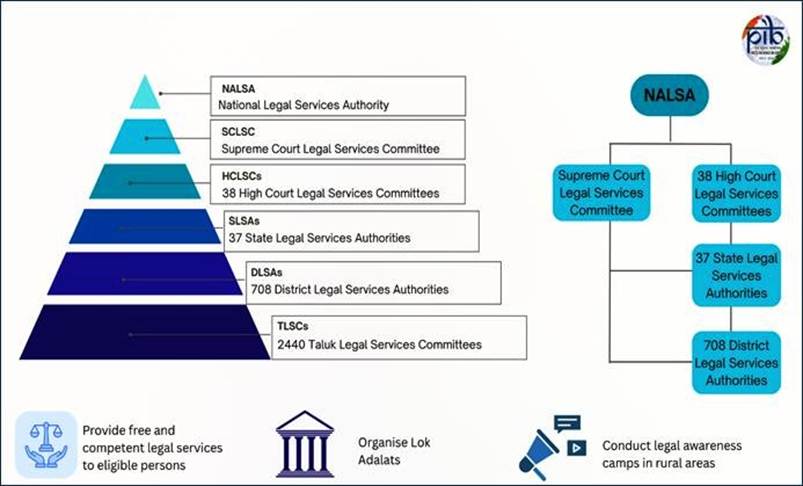
Achievements (2022–2025)
| Indicator | Achievement |
| People provided legal aid/advice | 44.22 lakh (2022–25) |
| Cases resolved via Lok Adalats | 23.58 crore (2022–25) |
| Beneficiaries under DISHA | 2.10 crore (till Feb 2025) |
| Legal Awareness Programmes | 13.83 lakh (2022–25) |
| People reached through awareness | 14.97 crore (2022–25) |
Lok Adalats
- Established under Sections 19–22 of the Act.
- Purpose: Speedy, amicable settlement of disputes (civil, criminal compoundable, pre-litigation).
- Types: National, State, District & Permanent Lok Adalats.
- Performance (2022–25):
- 23.58 crore cases resolved.
- Contributed to significant reduction in court pendency.
- Significance: Ensures affordable, participatory justice; saves time and resources.
Legal Aid Defence Counsel System (LADCS)
- Launched: 2023–26 (by NALSA) to ensure free defense in criminal cases.
- Coverage: 668 districts (as of Sept 2025).
- Performance:
- 11.46 lakh cases assigned; 7.86 lakh disposed.
- Outlay: ₹998.43 crore (2023–26).
- Objective: Strengthen institutional defense for the poor and undertrials.
Tech Initiatives
(a) DISHA Scheme (2021–26)
- Full form: Designing Innovative Solutions for Holistic Access to Justice.
- Outlay: ₹250 crore (GoI funded).
- Impact (as of Feb 2025):
- 2.10 crore people benefited.
- Covers pre-litigation advice, pro bono legal services, and awareness.
(b) Tele-Law Programme
- Integrates technology with legal aid via video conferencing.
- Gender Distribution (as of June 2025):
- Male: 60.4%
- Female: 39.6%
- Caste-wise Reach:
- OBC: 31.5%
- SC: 31.2%
- ST: 13.6%
- General: 23.7%
- Significance: Deepened legal access in rural and marginalized areas.
Awareness Programmes
- Aim: Empower citizens through knowledge of rights and procedures.
- Conducted by: NALSA, SLSAs, NGOs, and media partnerships.
- Data (2022–25):
- 13.83 lakh programmes.
- 14.97 crore attendees.
- Legal Literacy and Legal Awareness Programme (LLLAP) under DISHA:
- Conducted in 22 scheduled languages.
- Doordarshan aired 56 legal awareness shows in 6 languages reaching 70.7 lakh viewers.
- 21 webinars conducted (2021–25).
- Total outreach: Over 1 crore people.
Fast Track & Special Courts
- Objective: Speedy trial of gender and child-related cases, and other pending matters.
Fast-Track Courts (FTCs):
- Recommended: 1,800 (14th Finance Commission, 2015–20).
- Functional: 865 (as of June 2025).
Fast Track Special Courts (FTSCs):
- Launched: Oct 2019.
- Focus: Sexual offences & POCSO cases.
- Functional: 725 FTSCs (392 exclusive POCSO courts).
- Cases Disposed: 3,34,213 (as of June 2025).
- Funding: ₹1,952.23 crore (2020–26), including ₹1,207.24 crore from Nirbhaya Fund.
Gram Nyayalayas:
- Grassroot courts for rural justice.
- 488 functional (as of March 2025).
Nari Adalats:
- Under Mission Shakti (MWCD).
- 7–9 women-led community courts resolving domestic and gender-based disputes.
- Pilots: In 16 States + 2 UTs.
- Operational: 50 in Assam & J&K; smaller pilots in other areas.
Special Courts for SC/ST (PoA Act, 1989):
- 211 exclusive courts for atrocities-related cases.
Capacity Building
- National Judicial Academy: Advanced training for judges and legal aid functionaries.
- Para-Legal Volunteers Scheme (PLVs):
- Volunteers act as intermediaries between citizens and legal authorities.
- Training includes laws for women, children, labour, senior citizens.
- Training Programmes: 2,315 conducted (2023–May 2024).
- Training Modules: 4 specialized NALSA modules for Legal Aid Lawyers & PLVs.
Overview
| Dimension | Assessment |
| Accessibility | Technology-driven schemes (Tele-Law, DISHA) ensure last-mile delivery. |
| Speed of Justice | Lok Adalats + Fast-track courts reduce pendency. |
| Inclusivity | High SC/ST/OBC participation in Tele-Law; gender gap narrowing. |
| Financial Support | Dedicated multi-tier legal aid funds; LADCS & FTSCs backed by large allocations. |
| Challenges | Awareness gaps, digital divide, uneven state-wise performance, lack of legal literacy in remote regions. |
| Future Need | Expansion of Gram Nyayalayas, enhanced training, digitization of case monitoring, and legal aid outreach in regional dialects. |
Conclusion
- National Legal Services Day reinforces the constitutional mandate of justice, equality, and fairness.
- India’s legal aid network, anchored by NALSA, supported by technology and outreach, has become the world’s largest free legal aid system.
- Over the last decade, it has made justice more inclusive, participatory, and technology-driven, symbolizing the democratization of access to justice.


